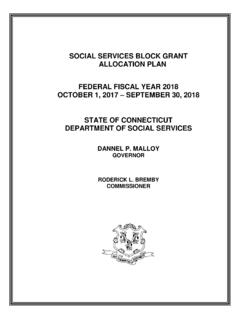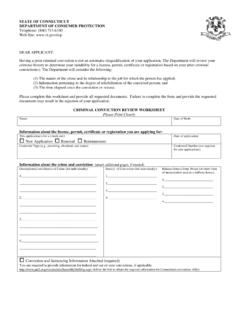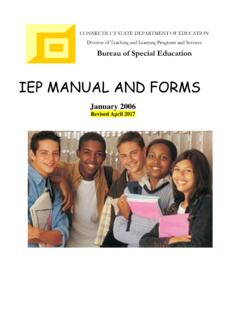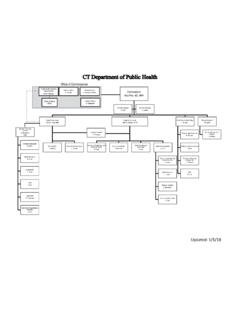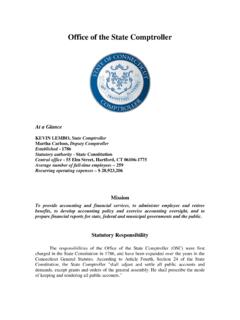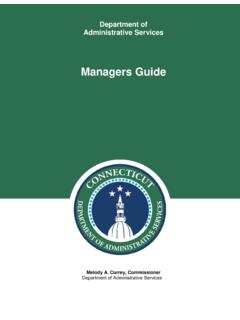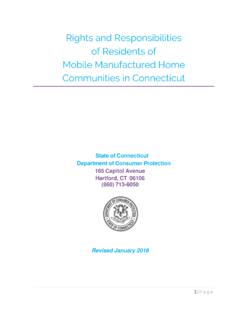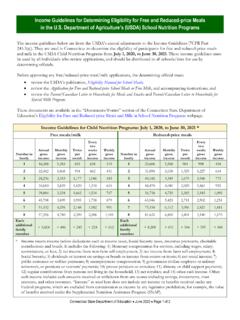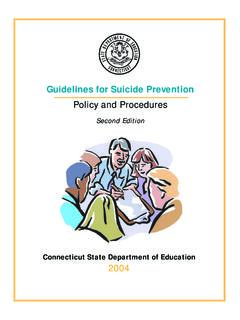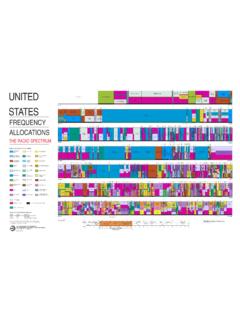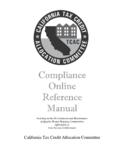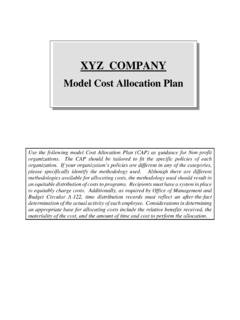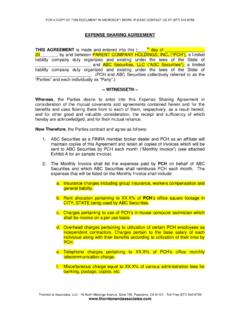Transcription of LOW INCOME HOME ENERGY ASSISTANCE PROGRAM BLOCK …
1 LOW INCOME HOME ENERGY ASSISTANCE PROGRAM BLOCK GRANT allocation PLAN October 1, 2021 September 30, 2022 AS APPROVED WITH AMENDMENT ON AUGUST 20,2021 STATE of CONNECTICUT DEPARTMENT OF SOCIAL SERVICES NED LAMONT GOVERNOR Submitted by: Deidre S. Gifford, MD, MPH, Commissioner Connecticut Department of Social Services TABLE OF CONTENTS I. INTRODUCTION 1 II. ADMINISTRATION 2 III. PROGRAM DEFINITIONS 3 IV. INCOME ELIGIBILITY 4 V. ELIGIBILITY CERTIFICATION 5 VI. PROGRAM INTEGRITY 7 VII. FRAUD 8 VIII. BASIC BENEFIT LEVELS 8 IX. RENTAL ASSISTANCE BENEFIT LEVELS 9 X. LIHEAP SNAP BENEFITS 10 XI. CRISIS ASSISTANCE 10 XII. SAFETY NET ASSISTANCE 10 XIII. PROGRAM DATES 11 XIV. CONSERVATION SERVICES 11 XV. ADDITIONAL BENEFITS / SERVICES 12 XVI. PAYMENTS 13 XVII. VENDORS 14 XVIII. FIXED MARGIN PROGRAM 15 XIX. INFORMATION AND REFERRAL 16 XX. ASSURANCE 16 ACTIVITIES 17 XXI. BUDGET 17 Page | 1 I. INTRODUCTION The Connecticut ENERGY ASSISTANCE PROGRAM (CEAP) is designed to help offset home ENERGY costs of Connecticut's lower INCOME households, specifically those households whose annual INCOME falls at or below 60 percent of the state median INCOME ($75,052 for a family of four).
2 The CEAP is funded by the Department of Health and Human Services' (HHS) Low INCOME Home ENERGY ASSISTANCE PROGRAM (LIHEAP) BLOCK Grant; however, at the time of the development of this allocation plan, the funding level for Federal Fiscal Year (FFY) 2022 has not been released. The estimated budget used in this allocation plan for the operation of the LIHEAP for FFY 2022 assumes that the PROGRAM will be level-funded at the FFY 2021 level of $73 million through Continuing Resolutions and includes an estimated $ million in FFY 2021 LIHEAP carry-forward funds, $400,000 in LIHEAP vendor refunds, and $58 million in American Rescue Plan Act funds for a total budget of $135 million. This constitutes the Department of Social Services best estimate of funding that may be available under the LIHEAP BLOCK grant ( the Plan ). DSS and the Community Action Agencies (CAAs) will work in conjunction with local governments, private human services providers, and the General Assembly's committees of cognizance, to assist Connecticut residents who are CEAP eligible in maximizing potential ENERGY ASSISTANCE options.
3 ENERGY ASSISTANCE benefits shall include the following: A. HEAT BENEFITS 1. Basic Benefit 2. Crisis ASSISTANCE Benefit 3. Safety Net ASSISTANCE Benefit B. RENTAL ASSISTANCE BENEFITS Benefits available through the CEAP vary to reflect need, cost, and/or ENERGY burden. The FFY 2022 Plan is designed to provide the highest level of ASSISTANCE to those households who have the lowest incomes and the highest ENERGY needs in relation to INCOME , considering household size and vulnerability. The provision of ASSISTANCE under CEAP is subject to the availability of funds. If funds provided for payments under the Plan are determined by the state to be in danger of exhaustion prior to the scheduled PROGRAM end date, the state reserves the right to close the PROGRAM or portions of the PROGRAM . If federal funding is provided in an amount higher or lower than the level assumed under the Plan, PROGRAM services and benefits may be adjusted. The Plan provides a framework for overall PROGRAM operation.
4 DSS will develop and implement policies and procedures to further define the rules of operation. LOW INCOME HOME ENERGY ASSISTANCE PROGRAM BLOCK GRANT allocation PLAN For Federal Fiscal Year 2022 October 1, 2019 September 30, 2020 Page | 2 II. ADMINISTRATION The Department of Social Services responsibilities in the administration of the CEAP are to: A. Prepare and submit the LIHEAP allocation Plan to the Governor and, following legislative approval, submit the Plan to the federal government. B. Compile and submit any PROGRAM reports required under state and federal law to the appropriate bodies. C. Act as grantee agency for the state for all LIHEAP funds. D. Ensure coordination of the CEAP with other ENERGY and conservation ASSISTANCE programs offered by the state and other public or private entities. E. Contract with Community Action Agencies (CAAs) or any other non-profit or for-profit entities to provide standardized services to all eligible households; including those households receiving ASSISTANCE from DSS programs, and to process applications from any such households wishing to apply for benefits.
5 F. Execute agreements with ENERGY vendors to ensure PROGRAM standardization and provide current lists of eligible vendors to DSS contractors. G. Ensure vendors are paid no later than thirty (30) business days after the CAA s receipt of an authorized fuel slip or invoice for payment from the vendor. H. Provide CAAs with lists of households whose Temporary Family ASSISTANCE benefits are being discontinued as a result of time limitations. I. Provide informational materials to inform clients in writing of other ENERGY and conservation related programs administered or funded by the state. J. Complete weekly and quarterly fiscal and PROGRAM activity reports. K. Allocate personnel resources necessary to provide reasonable protection against client or vendor fraud, develop anti-fraud strategies designed to strengthen PROGRAM integrity, maintain a fraud referral method for reporting suspected PROGRAM abuse and investigate all reported claims of suspected PROGRAM abuse.
6 L. Track carry-forward funds from the 2020/2021 PROGRAM year. M. Develop an estimated budget of total expenditures for the PROGRAM year, and for DSS and each contracting agency, a line-item budget of administrative expenditures for CEAP. The budget shall be based on the release of the BLOCK grant funding level or if the release is delayed, using the assumption that the BLOCK grant will be level-funded at the prior PROGRAM year. N. Provide CAAs with the daily price per gallon for home heating oil purchased under the CEAP. O. Track the number of gallons of home heating oil purchased under the CEAP. Track the average fixed margin price, the average retail price, and savings per gallon for heating oil. P. Monitor the performance of the CAAs and PROGRAM vendors in delivering services and in reporting to DSS. Page | 3 Q. Provide standard application forms and format for all ENERGY programs administered by the Department. The application form shall include a statement that non-qualified aliens are not eligible for ENERGY ASSISTANCE benefits (other household members who are either qualified aliens or citizens may be eligible for ENERGY ASSISTANCE benefits).
7 R. Maintain a system to verify recipients Social Security Numbers as part of the ongoing effort to maximize PROGRAM integrity. III. PROGRAM DEFINITIONS For the purposes of the Plan the following terms are defined: Boarders - Persons whose meals are included in their rent. Boarders are not eligible to receive CEAP benefits. Categorical Eligibility A determination that a household is eligible for LIHEAP ASSISTANCE based on eligibility and enrollment in another means-tested PROGRAM including: Temporary ASSISTANCE for Needy Families (TANF), the Supplemental Nutrition ASSISTANCE PROGRAM (SNAP), Refugee Cash ASSISTANCE , or Supplemental Security INCOME (SSI). If a household is determined categorically eligible, intake staff do not need to repeat the INCOME test for purposes of qualifying for LIHEAP ASSISTANCE . Dwelling Unit Any residential property, ( , apartment, house, or stationary mobile home) in which the occupants have exclusive kitchen facilities.
8 It does not include commercial property, accommodations that have not been issued a certificate of occupancy or accommodations that are not listed as residential units in the tax assessor s records for the municipality where such accommodations are located. ENERGY Burden The percentage of household INCOME spent on home ENERGY costs. Household - Any individual or group of individuals who: are living together in a dwelling unit; or who purchase residential ENERGY in common; or who make payments for such ENERGY in the form of rent. Persons renting a room(s) within a dwelling unit are considered to be household members. Households do not include individuals who are boarders in rooming houses, who reside at an institution of higher learning, are incarcerated, or are foster children or foster adults. INCOME /Means of Support - Gross salaries/wages, tips, pensions, dividends, annuity distributions, interest, gross rental INCOME , estate or trust INCOME , royalties, social security and veterans benefits (excluding Aid and Attendance pension benefits), unemployment compensation, workers' compensation, monetary and non-monetary contributions from friends and relatives, alimony, child support, lottery winnings, self-employment INCOME , and governmental ASSISTANCE not otherwise excluded as INCOME .
9 Life-tenant A person entitled by law to occupy a property or dwelling for the duration of his/her life and who is responsible for maintaining the property. Life-Threatening Situation - Any situation in which an eligible household is unable to secure primary deliverable heating fuel and is without (or within one week of) being without heating fuel. Non-Qualified Aliens Individual(s) who are in this country illegally and individual(s) who are here legally but temporarily, on student, tourist, or work visas. Primary Source of Heat The principal fuel source used by a household to heat its dwelling unit. Page | 4 Rental ASSISTANCE Households Households which do not make direct vendor payments for their primary source of heat. Such households include owners of dwelling units where the primary source of heat is not individually metered and is not separately billed to the household by a vendor. Retail Price The price charged by a vendor for services or product, exclusive of any discounts, delivered or provided to similarly situated, non-CEAP households.
10 Refugee Cash ASSISTANCE DSS administered federal funds related to the resettlement of refugees, assigned by the State Department to local affiliates of national voluntary resettlement agencies in Connecticut. State Supplement to the Aged, Blind and Disabled PROGRAM (State Supp) a state-funded PROGRAM that provides a cash ASSISTANCE benefit to individuals who receive SSI or other INCOME necessary to pay for basic living expenses. Supplemental Security INCOME (SSI) A federal INCOME supplement PROGRAM designed to help aged, blind, and disabled people, who have little or no INCOME ; and it provides cash to meet basic needs for food, clothing, and shelter. Supplemental Nutrition ASSISTANCE PROGRAM (SNAP) A federally funded PROGRAM administered by the Department of Agriculture and DSS that provides nutrition benefits to supplement the food budget of needy families so they can purchase healthy food and move towards self-sufficiency. Temporary ASSISTANCE for Needy Families (TANF) A federal BLOCK grant administered by the Office of Family ASSISTANCE (OFA) in ACF/HHS (Administration of Children and families within the US Department of Health and Human Services) and DSS to help low- INCOME families with children achieve economic self-sufficiency.
